The Connected Sensors Market is estimated to be valued at USD 2.8 billion in 2025 and is projected to reach USD 8.7 billion by 2035, registering a compound annual growth rate (CAGR) of 12.0% over the forecast period.
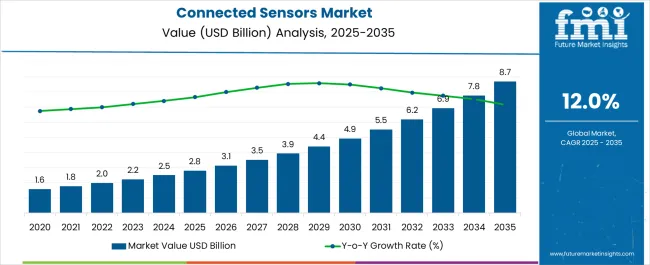
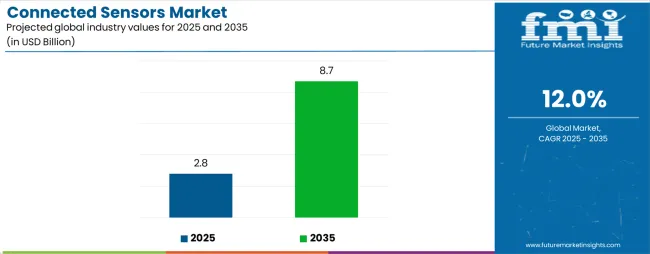
| Metric | Value |
|---|---|
| Connected Sensors Market Estimated Value in (2025 E) | USD 2.8 billion |
| Connected Sensors Market Forecast Value in (2035 F) | USD 8.7 billion |
| Forecast CAGR (2025 to 2035) | 12.0% |
The Connected Sensors market is experiencing rapid expansion, driven by the growing need for real-time data monitoring, predictive analytics, and automation across diverse industries. Connected sensors are increasingly deployed in applications ranging from industrial automation and smart cities to healthcare and environmental monitoring, where they provide actionable insights that improve decision-making and efficiency. Rising adoption of IoT platforms, edge computing, and AI-powered analytics has significantly enhanced the functionality and value of these devices, enabling organizations to move from reactive to predictive operations.
Additionally, the proliferation of smart infrastructure and connected devices is creating a large ecosystem that relies on sensor-based data to optimize performance and resource management. Regulatory emphasis on safety, energy efficiency, and sustainability is further boosting adoption across multiple verticals.
With increasing demand for interoperability and scalable architectures, connected sensors are becoming integral components of digital transformation strategies The ability to reduce operational costs, extend asset lifecycles, and ensure compliance positions the Connected Sensors market for sustained growth over the coming decade.
The connected sensors market is segmented by component, industry, and geographic regions. By component, connected sensors market is divided into Hardware, Software, and Network Components. In terms of industry, connected sensors market is classified into IT And Telecommunications, Manufacturing, Transportation And Logistics, Defense And Government, BFSI, Healthcare, Retail, Energy And Utilities, and Others. Regionally, the connected sensors industry is classified into North America, Latin America, Western Europe, Eastern Europe, Balkan & Baltic Countries, Russia & Belarus, Central Asia, East Asia, South Asia & Pacific, and the Middle East & Africa.
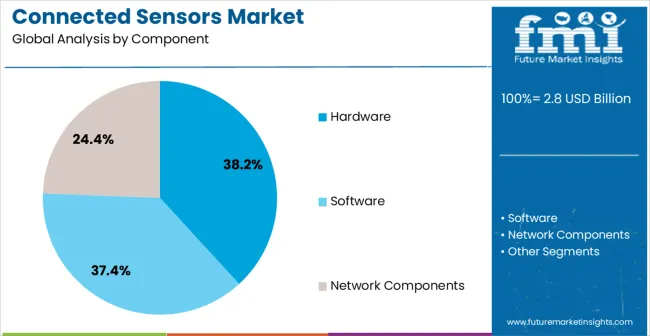
The hardware component segment is projected to hold 38.2% of the Connected Sensors market revenue in 2025, making it the leading component type. This dominance is being driven by the increasing demand for advanced sensor modules, transducers, and integrated chipsets that enable accurate data capture and transmission. Hardware is central to the performance of connected systems, as improvements in miniaturization, energy efficiency, and wireless connectivity enhance reliability and scalability.
Ongoing advancements in sensor technology, such as multi-sensing capabilities and low-power designs, are expanding their use across industrial, healthcare, and consumer applications. Manufacturers are investing in hardware innovation to improve durability and adaptability in challenging environments, further supporting widespread adoption.
The critical role of hardware in supporting AI algorithms, cloud integration, and edge computing makes it indispensable for connected ecosystems As industries demand higher levels of precision, faster data transfer, and robust sensor networks, the hardware segment is expected to maintain leadership, with growth reinforced by continuous technological development and strong demand for reliable connected devices.
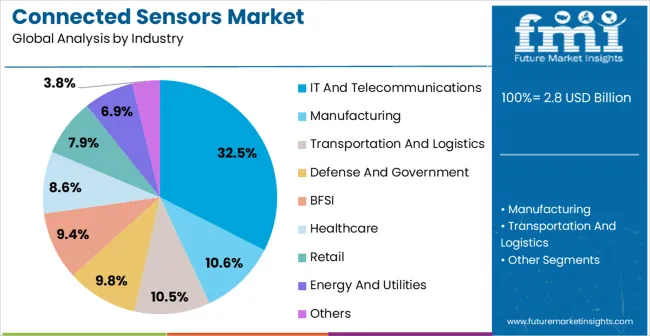
The IT and telecommunications industry segment is anticipated to account for 32.5% of the Connected Sensors market revenue in 2025, positioning it as the leading industry vertical. Growth in this segment is being fueled by the increasing reliance on connected infrastructure for network monitoring, data traffic management, and enhanced customer services. Connected sensors enable telecom operators and IT service providers to monitor equipment health, optimize energy consumption, and ensure network reliability.
Their integration into data centers, base stations, and smart networking systems allows for predictive maintenance and reduced downtime, which significantly improves operational efficiency. With the rise of 5G technology and increasing demand for high-speed connectivity, connected sensors are becoming critical for supporting massive device deployments and real-time analytics.
Enhanced capabilities such as automated fault detection, environmental monitoring, and adaptive load balancing are strengthening their role within IT and telecommunications infrastructure As digital transformation accelerates and demand for resilient network ecosystems grows, the IT and telecommunications industry is expected to remain a primary driver of connected sensor adoption.
Connected Sensors market in Internet of Things (IoT) connected devices is showing a dynamic growth rate in many enterprise. The physical objects that are connected will have one or more sensors. Every sensor can monitor a specific location, vibration, motion and temperature.
This sensors are connected to each other and to the system and can recognize the real time information from the sensor’s data feed in IoT. So for enterprises this connected sensors will provide new information to enterprise system. Due to advanced technology, there is greater investment in sensor devices that are having access to real-time information and services for enterprise.
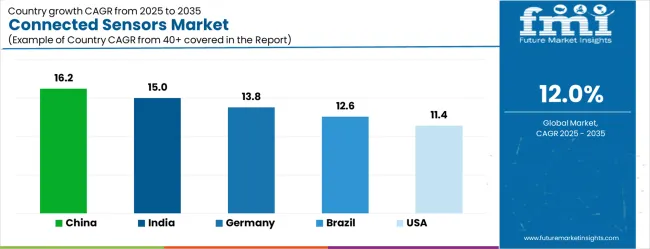
| Country | CAGR |
|---|---|
| China | 16.2% |
| India | 15.0% |
| Germany | 13.8% |
| Brazil | 12.6% |
| USA | 11.4% |
| UK | 10.2% |
| Japan | 9.0% |
The Connected Sensors Market is expected to register a CAGR of 12.0% during the forecast period, exhibiting varied country level momentum. China leads with the highest CAGR of 16.2%, followed by India at 15.0%. Developed markets such as Germany, France, and the UK continue to expand steadily, while the USA is likely to grow at consistent rates. Japan posts the lowest CAGR at 9.0%, yet still underscores a broadly positive trajectory for the global Connected Sensors Market.
In 2024, Germany held a dominant revenue in the Western Europe market and is expected to grow with a CAGR of 13.8%. The USA Connected Sensors Market is estimated to be valued at USD 1.1 billion in 2025 and is anticipated to reach a valuation of USD 1.1 billion by 2035. Sales are projected to rise at a CAGR of 0.0% over the forecast period between 2025 and 2035. While Japan and South Korea markets are estimated to be valued at USD 137.4 million and USD 84.1 million respectively in 2025.
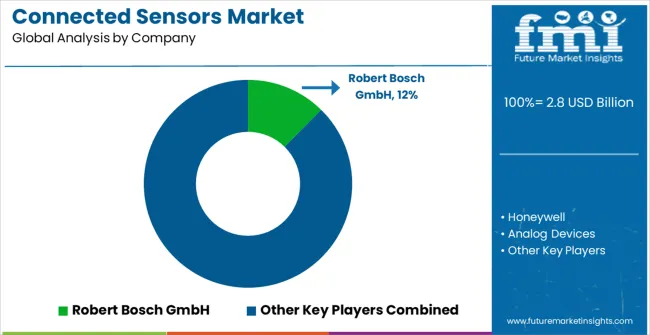
| Item | Value |
|---|---|
| Quantitative Units | USD 2.8 Billion |
| Component | Hardware, Software, and Network Components |
| Industry | IT And Telecommunications, Manufacturing, Transportation And Logistics, Defense And Government, BFSI, Healthcare, Retail, Energy And Utilities, and Others |
| Regions Covered | North America, Europe, Asia-Pacific, Latin America, Middle East & Africa |
| Country Covered | United States, Canada, Germany, France, United Kingdom, China, Japan, India, Brazil, South Africa |
| Key Companies Profiled | Robert Bosch GmbH, Honeywell, Analog Devices, NXP Semiconductors, Infineon Technologies, Silicon Laboratories, ABB, InvenSense (TDK), Panasonic, Texas Instruments, STMicroelectronics, TE Connectivity, Omron, Semtech, Sensata Technologies, Vishay, and Sensirion AG |
The global connected sensors market is estimated to be valued at USD 2.8 billion in 2025.
The market size for the connected sensors market is projected to reach USD 8.7 billion by 2035.
The connected sensors market is expected to grow at a 12.0% CAGR between 2025 and 2035.
The key product types in connected sensors market are hardware, software and network components.
In terms of industry, it and telecommunications segment to command 32.5% share in the connected sensors market in 2025.






Our Research Products

The "Full Research Suite" delivers actionable market intel, deep dives on markets or technologies, so clients act faster, cut risk, and unlock growth.

The Leaderboard benchmarks and ranks top vendors, classifying them as Established Leaders, Leading Challengers, or Disruptors & Challengers.

Locates where complements amplify value and substitutes erode it, forecasting net impact by horizon

We deliver granular, decision-grade intel: market sizing, 5-year forecasts, pricing, adoption, usage, revenue, and operational KPIs—plus competitor tracking, regulation, and value chains—across 60 countries broadly.

Spot the shifts before they hit your P&L. We track inflection points, adoption curves, pricing moves, and ecosystem plays to show where demand is heading, why it is changing, and what to do next across high-growth markets and disruptive tech

Real-time reads of user behavior. We track shifting priorities, perceptions of today’s and next-gen services, and provider experience, then pace how fast tech moves from trial to adoption, blending buyer, consumer, and channel inputs with social signals (#WhySwitch, #UX).

Partner with our analyst team to build a custom report designed around your business priorities. From analysing market trends to assessing competitors or crafting bespoke datasets, we tailor insights to your needs.
Supplier Intelligence
Discovery & Profiling
Capacity & Footprint
Performance & Risk
Compliance & Governance
Commercial Readiness
Who Supplies Whom
Scorecards & Shortlists
Playbooks & Docs
Category Intelligence
Definition & Scope
Demand & Use Cases
Cost Drivers
Market Structure
Supply Chain Map
Trade & Policy
Operating Norms
Deliverables
Buyer Intelligence
Account Basics
Spend & Scope
Procurement Model
Vendor Requirements
Terms & Policies
Entry Strategy
Pain Points & Triggers
Outputs
Pricing Analysis
Benchmarks
Trends
Should-Cost
Indexation
Landed Cost
Commercial Terms
Deliverables
Brand Analysis
Positioning & Value Prop
Share & Presence
Customer Evidence
Go-to-Market
Digital & Reputation
Compliance & Trust
KPIs & Gaps
Outputs
Full Research Suite comprises of:
Market outlook & trends analysis
Interviews & case studies
Strategic recommendations
Vendor profiles & capabilities analysis
5-year forecasts
8 regions and 60+ country-level data splits
Market segment data splits
12 months of continuous data updates
DELIVERED AS:
PDF EXCEL ONLINE
Connected Diagnostics Market Size and Share Forecast Outlook 2025 to 2035
Connected RHM (Remote Healthcare Monitoring) Market Size and Share Forecast Outlook 2025 to 2035
Connected Aircraft Market Size and Share Forecast Outlook 2025 to 2035
Connected Packaging Market Size and Share Forecast Outlook 2025 to 2035
Connected Living Room Market Size and Share Forecast Outlook 2025 to 2035
Connected Toys Market Size and Share Forecast Outlook 2025 to 2035
Connected Vehicle Technology Market Size and Share Forecast Outlook 2025 to 2035
Connected Tire Market Size and Share Forecast Outlook 2025 to 2035
Connected Logistics Market Growth - Trends, Demand & Innovations 2025 to 2035
Connected Drug Delivery Devices Market Size and Share Forecast Outlook 2025 to 2035
Connected Home Surveillance Devices Market Growth - Trends & Forecast 2025-2035
Sensors Market Analysis by Type, Technology, End User & Region - Forecast from 2025 to 2035
Connected Game Console Market Analysis by Product Type, Application, and Region through 2035
Understanding Connected TV Market Share & Growth Trends
Connected TV’s Market Outlook 2025 to 2035
Connected Healthcare Market
Connected Car Market Growth – Trends & Forecast 2024-2034
AI-Driven Smart Home Appliances – Enhancing Home Automation
Connected Lighting Platform Market
Connected Enterprise Video Surveillance Solutions Market

Thank you!
You will receive an email from our Business Development Manager. Please be sure to check your SPAM/JUNK folder too.
Chat With
MaRIA